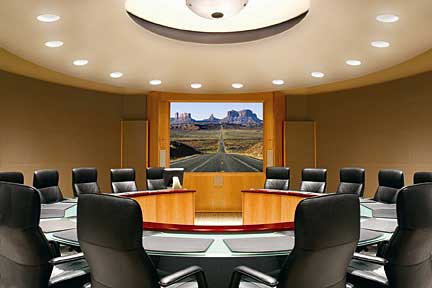Match Game: Specifying the Right Projection Screen for the Presentation Space
Ambient Light Levels
Ambient light is the light present in a room that is not produced by the projector. Ambient light is composed of overhead electric lighting, natural light streaming in through the windows, and the reflections of that light in the space, for instance, off of light colored walls or reflective picture frames. The presence of ambient light has a significant impact on the amount of light output or type of projection screen that is
necessary to achieve an appropriate contrast between the projected image and its surroundings.
|
To determine the level of ambient light in a presentation or performance space, it is important to ask the people that will be using the space how they want to view the screen. In conference rooms and classrooms, most people prefer to leave the overhead lights on or faintly dimmed, so that employees or students can take notes or follow along in supporting materials during the presentation. In these presentation scenarios, a large amount of ambient light must be accommodated. In movie theaters, the lights are lowly dimmed and used primarily to illuminate stairs and exits. In these situations, ambient light is much less of an issue.
To describe the level of ambient light in a presentation space, rooms are often categorized as either dark rooms, which contain little or no ambient light, moderately lit rooms, or brightly lit rooms. As previously outlined, the light that a projector emits is measured in lumens. The light that is reflected or transmitted off of a projection screen is measured in lamberts. In order for the audience to see the projected image clearly, the minimum contrast ratio of the image reflected off of the screen in relationship to the screen's surrounding or ambient light level is approximately 5:1.
Reaching the appropriate contrast ratio can be accomplished a few different ways. First, the ambient light could be reduced by specifying materials that absorb light, such as dark fabrics or paint. Electric lights can be controlled with dimmers and window treatments could be specified to control the presence of natural light in the space.
If better control of the ambient light is not an option, then a projector with a higher output could be selected. Increasing the intensity of the light shot from the projector onto the screen will, subsequently, increase the brightness of the image reflected off of the screen. Shrinking the size of the projection screen will also improve the brightness of the image, but may make the screen too small to be viewed comfortably by the most distant viewer and, therefore, is not considered a viable option for maintaining an appropriate contrast ratio.
Viewing Angles
One of the performance specifications that architects will find on any projection screen is the viewing angle. The viewing angle is the maximum angle at which a display can be viewed with acceptable definition
-without being garbled, blurring, or too faint to see clearly. While designing a presentation space, it is important that the seats of the
audience all fall well within the viewing angles of the projection screen.
To envision a viewing angle, imagine that a member of the audience is sitting in line with the center of the projection screen. That viewer is considered on-axis. Now imagine that the projection screen represents one axis and a second axis is drawn from the center of the projection screen through the on-axis viewer, creating a right angle. If the screen specified for the project has a viewing angle of 60 degrees, then a 60 degree angle can be drawn to both the right and left of the center viewer. These two angles define what is commonly referred to as the viewing cone. No seats should be planned outside of the viewing cone, because the image that the people in those seats will have of the screen will be distorted.
Projection screens today are manufactured to offer a wide range of viewing angles. A 60-degree viewing angle is considered especially wide. A 45-degree viewing angle is considered moderate. A narrow viewing angle will measure about 30-degrees.










